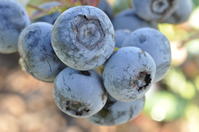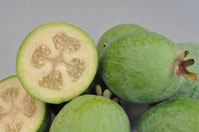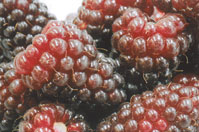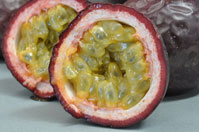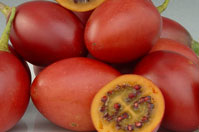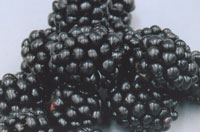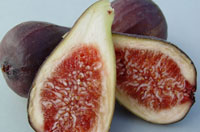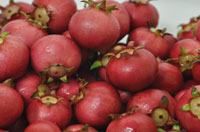
Fig |

|
Key Points
- A 'back to the future' crop with commercial potential.
- Prefers a sunny situation with rich, heavy, well-drained soil.
- Varieties available to spread harvest from January to April.
- Can be grown in most parts of N.Z.
- Hardly any serious pest and disease problems.
Climate
Temperature
Figs enjoy warm summers and cool winters. They accommodate well to a wide range of climatic conditions and established trees will withstand quite extreme heat.
Frost Tolerance
The trees are hardy down to sub-zero temperatures but a -3°C or heavier frost in spring or early autumn can damage soft new growth or maturing fruit. This shouldn't present any problems with early fruiting varieties but may be a consideration when growing later fruiting varieties in cooler districts.
Chill Hours
N/A
NZ climate charts
You can read more about NZ's Cold Hardiness and Climate Zone here
Wind/Shelter
Large leaves and a rapid growth habit means that wind damage to both the fruit and the tree structure is possible in exposed sites, especially when the branches are loaded with mature fruit. The provision of shelter is regarded as essential for commercial fig plantings. Planting live shelter to filter the prevaling winds will also assist in reducing moisture loss through transpiration.
Sunshine Hours
An open, sunny site suits figs best. They prefer warm, dry conditions (as long as they have adequate moisture at the roots) and, generally, the sunnier the site, the earlier the crop.
Rainfall
It is possible to grow figs without any supplementary watering. However, managed irrigation is a must to ensure stress-free growth along with maximum fruit size and quality. The ripening fruit is prone to splitting when soil moisture levels fluctuate from dry to excessively wet. Be aware, though, that figs hate to have their roots sitting in water-logged soil for extended periods so applications should be carefully monitored to maintain even levels throughout the growing season.
Soil Requirements
Soil Type
Figs have vigorous root systems and will survive in almost any soil but the ideal is a fertile, heavy, free-draining soil with the ability to retain moisture through dry periods. Well-drained clay loams are fine but heavy, impervious clays that remain water-logged for extended periods are unsuitable for commercial production as are very light, sandy soils that fail to retain moisture and nutrients.
Drainage
Soils prone to excessive water-logging can cause problems as figs are extremely susceptible to root rots. Sub-soiling should be considered if there is any question of the natural drainage being inadequate. Excessively wet sites may require contouring to create raised beds and/or artificial drainage such as pipe or mole drains. More expense!
pH & Soil Testing
Figs prefer soils with a pH of 6.0-6.5. An initial soil test is essential not only to identify the soil pH but also to indicate if nutrient levels need adjusting prior to planting. Annual soil and/or leaf analysis in winter will determine if adjustments to the soil pH or nutrient levels are required.
Spacing
This depends entirely on the growing methods used and the intended ultimate size of the trees. Large individual trees may need up to 6m spacings within the row and a 5m service strip between the rows whereas trellis trained plants may be planted as close as 1.8m to 2.4m in the rows with a 3m to 4m access strip inbetween.
Crop Establishment
Selecting Varieties
Choice will depend upon location, climate and the intended end-use. See our individual variety notes for more information.
Planting Time
Autumn/early winter planting from March-June is fine in the warmer areas of N.Z or spring September-October in cooler districts. Root growth commences when the soil temperature reaches 8-10°C.
Cultivation
Eradicate perennial weeds and cultivate either the whole site or just the planting strips for the rows. Finalise any necessary drainage work.
Fertiliser
Incorporate any nutrients required to achieve a suitable pH and a good base level of fertility as indicated by your soil test, preferably six monjths or so before setting out the trees. If this is done, no further fertiliser application will be necessary at planting time.
Irrigation
Young figs grow rapidly as they become established. Thorough irrigation is recommended at planting time to settle the young plants into position and to minimise transplant shock.
Tips
Water the plants thoroughly before planting and ensure that the roots are never allowed to become dry once they have been removed from their pots. Disturb the root-ball as little as possible and plant the young trees firmly at approximately the same depth as they are in their containers with just a light covering of soil over the roots. Staking is usually not necessary but may have to be considered in extremely exposed situations where wind-wrenching might prohibit new root development.
Crop Maintenance
Fertiliser
Feeding figs is still an inexact science, however some general principles seem to apply. Given a good base level of soil fertility figs may not require any applications of supplementary fertiliser for the first couple of years but, once they commence significant fruiting the demand for nutrients will start to increase. High nitrogen fertilisers early in the season will promote vegetative growth at the expense of fruit but reasonable levels nitrogen plus potassium appear to be beneficial later as the fruit develops ond matures. High levels of sodium and chloride are detrimental and must be avoided. Annual soil and leaf testing can be used, along with orchard appearance, performance records and information regarding previous applications, to establish a suitable fertiliser regime to replace the nutrients extracted by the crop.
Irrigation
Efficient irrigation is a must throughout the growing season and the provision of adequate soil moisture is especially important as fruit forms , swells and matures as extremes of dry and wet will cause reduced yields from fruit splitting.
Drip irrigation is suited to fig production because it delivers water directly to the roots whilst leaving foliage and fruit dry but, again, careful monitoring is required to ensure that system is working efficiently and that the vines are receiving the correct amount of water while, at the same time, minimising the chances of root-rots developing because of over-watering.Pest & Disease Control
Suprisingly few insects create problems with figs. Watch out for lemon tree borer that may be attracted to fresh pruning cuts and severely damage even quite large trunks and branches. Fortunately it gives itself away by the sawdust deposits excreted from holes in the bark and can be controlled by making sure that all large cuts are painted over and by injecting a suitable insecticide into the holes. Slaters and earwigs can invade the ripe fruit but are usually controlled by good orchard hygiene.
Other than being susceptible to root rots if soils are poorly drained, figs are generally resistant to most fungal diseases. Botrytis can be problem in areas with high rainfall, especially during autumn and winter, and rust may appear on the undersides of the foliage in times of prolonged warm, humid conditions. Again, good hygiene will help minimise the chances of infection and having good air-flow through the orchard can reduce humidity around the trees. Whether or not to apply chemicals is a decision for the individual grower to make but here at Tharfield we use an IPM Services Ltd integrated pest management program that requires us to regularly monitor our crops, to maintain high standards of nursery hygiene and, where appropriate, to make efficient use of predator insects in order to minimise the need for chemical controls.Weed Control
Young figs especially struggle to compete with weeds and grasses, so efficient weed control around the trees is crucial to promote maximum growth. Because the fig's shallow, fibrous root system is easily damaged by hoeing or tilling, the careful application of suitable residual herbicides is favoured by many growers along with regular mowing of the grass swathes between the rows. If artificial weed-mat mulches are used in the rows care needs to be taken to ensure that it doesn't become a breeding ground for fruit-invading slugs, earwigs and slaters that can thrive in that environment.
Bird Control
Birds love ripe figs so control measures are usually required. The ideal method is probably bird netting over a support structure that will allow pickers easy access. Figs are a long-term crop with trees producing for many decades and the costs involved in providing protection should be quickly recouped with the resulting increase in yield.
Pollination
No pollination help is required. A fig is the flower.
Harvest & Handling
Picking
Most varieties of figs must be fully ripe before harvesting. This means that daily picking is required especially during the hot summer months. Speedy, accurate harvesting requires experienced pickers as fruit selection is based on appearance, feel and, for some varieties, skin colour. Ripe figs have a fine skin texture and they must be handled with great care to minimise the chances of causing abrasions or bruising that will reduce their shelf-life. Gloves should be worn to provide protection from the milky latex sap exuding from the severed stalks.
Post Harvest
There are several different opinions on post-harvest handling but most agree that the temperature of the ripe fruit needs to be reduced a.s.a.p. Some prefer to lightly chill prior to grading and packing and then refrigerate further down to 1°C - 4°C. Other growers take the fruit to the lower temperatures immediately after picking. Either way, once the fruit refrigerated it needs to be maintained at these temperatures until sold to the final consumer. Speed in reaching markets is essential as, even under ideal conditions, fresh figs generally only have storage life of 5 - 7 days in peak condition.
Expected Yield
So many factors can influence yields from commercial fig orchards that it would be misleading of us to indicate possible yields.
More Information
- Growing Figs in New Zealand - Eric Cairns, New Zealand Tree Crops Association Inc
- Temperate and Subtropical Fruit Production, 2nd Edition - Edited by D.I.Jackson and N.E. Looney, CABI Publishing
- IPM Services (2009) Ltd
Enquiry
Please email Andrew Boylan, andrew.boylan@edible.co.nz for quotes or for any other queries you may have regarding our products and services. Minimum orders of 50 units per variety.
So that Andrew can respond to your enquiery promptly, please tell us:
- Your address (so we have some idea of your climate)
- The variety you are interested in
- The approximate numbers required
- Whether you a new grower or an established producer?
Many thanks
